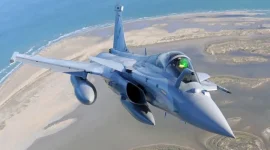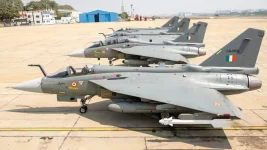- Views: 2K
- Replies: 15

India's air superiority over Pakistan is significantly strengthened by its substantial advantage in precision-guided munitions.
The Indian Air Force (IAF) possesses a considerable strategic advantage over the Pakistan Air Force (PAF) due to its superior inventory of stand-off weapons (SOWs) and precision-guided munitions (PGMs). This 4:1 advantage in stockpiles is crucial for maintaining air dominance and ensuring the effectiveness of India's air power in any potential conflict.
SOWs and PGMs are fundamental to modern air combat, allowing air forces to strike targets with high accuracy from safe distances, minimizing risks to aircraft and pilots. The IAF's diverse inventory encompasses a wide array of air-to-ground and air-to-air missiles, glide bombs, and smart munitions, sourced from both domestic and international manufacturers. This combination of quantity and technological diversity provides the IAF with exceptional flexibility and lethality.
India's sustained investment in defence modernization has been instrumental in building this advantage. Indigenous programs like the DRDO-developed Smart Anti-Airfield Weapon (SAAW) and BrahMos-A supersonic cruise missile, along with acquisitions from countries like Israel, France, and Russia, have significantly bolstered India's arsenal. Systems such as the Spice-2000 guided bombs, Rafale's SCALP cruise missiles, and the Hammer precision-guided munitions have further augmented the IAF's strike capabilities.
In contrast, Pakistan's reliance on a limited inventory of precision munitions, primarily acquired from China and with constrained indigenous development, restricts its operational flexibility. While platforms like the JF-17 Thunder have been equipped to deliver Chinese PGMs, their scale and technological sophistication do not match the breadth and capability of the IAF's arsenal. Furthermore, the lack of adequate stockpiles limits the PAF's ability to sustain prolonged operations in high-intensity conflicts.
The advantage of a larger SOW and PGM stockpile extends beyond precision strikes. It enhances the IAF's capacity to execute a range of missions, including pre-emptive strikes, suppression of enemy air defences (SEAD), and long-range interdiction. This capability allows the IAF to achieve a strategic upper hand in any conflict, ensuring dominance over key battle spaces and minimizing potential collateral damage.
India's focus on increasing indigenous production of SOWs and PGMs through initiatives like the Make-in-India program has ensured a steady supply chain and reduced dependence on foreign suppliers. This self-reliance strengthens India's strategic posture, allowing the IAF to replenish its stockpiles even during protracted conflicts, a capability Pakistan lacks due to its reliance on external sources.
The stockpile advantage also enables the IAF to maintain a credible deterrent posture. The ability to strike with precision and sustain operations sends a strong message to adversaries, reinforcing India's position as a dominant regional power. It also allows the IAF to dictate terms in a conflict scenario, ensuring that any escalation would be met with a decisive and overwhelming response.
In conclusion, the IAF's 4:1 advantage over the PAF in SOW and PGM inventory is a cornerstone of India's air power strategy. It enhances operational readiness and serves as a critical factor in maintaining regional stability. By continuing to invest in modernization and self-reliance, India ensures that this advantage remains a key pillar of its defence capabilities for the foreseeable future.



